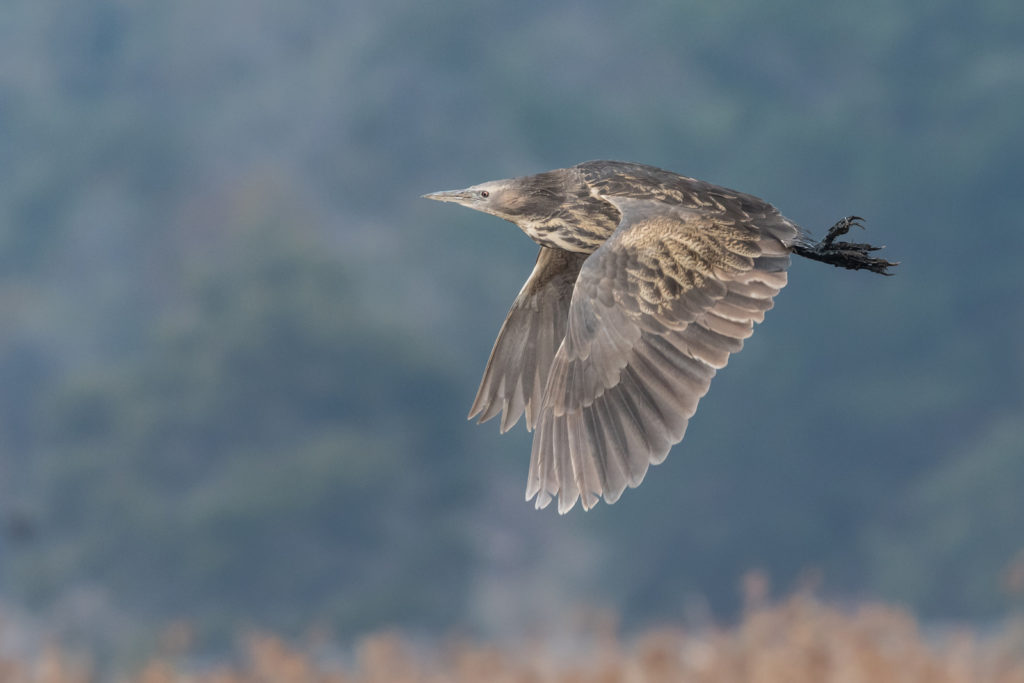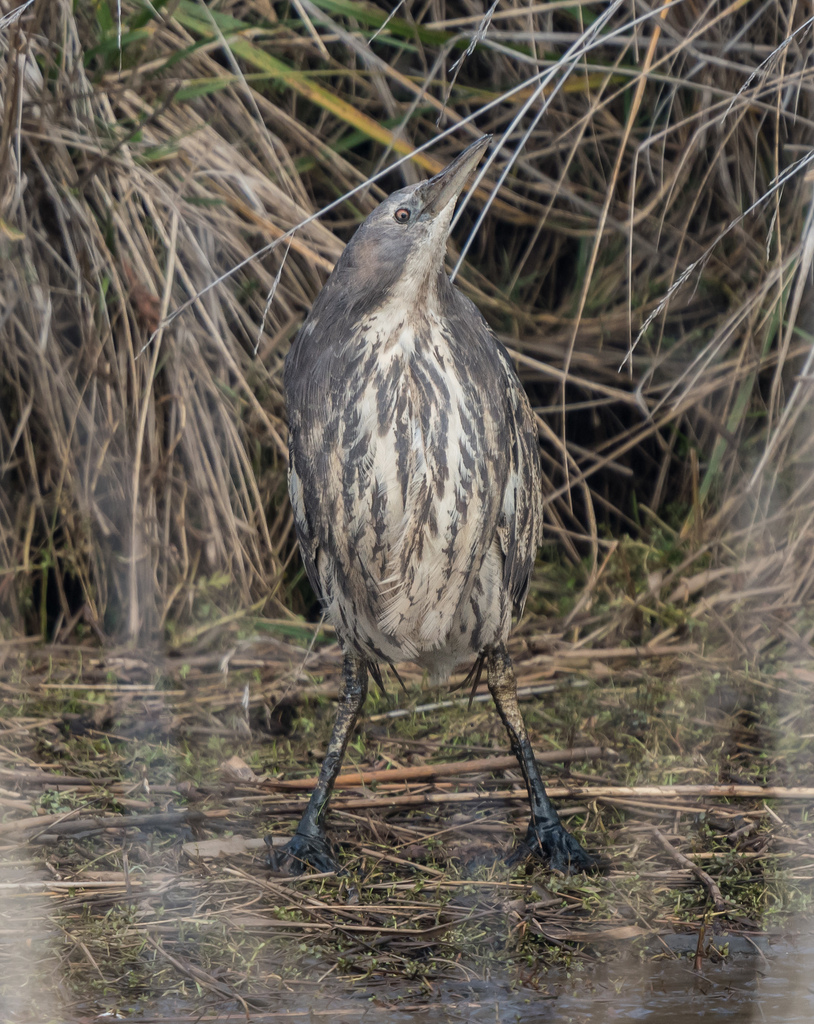Landcare news and opportunities
Opportunities and awards
- Grants available to manage serrated tussock: The Victoria Serrated Tussock Working Party is providing community groups and organisations with the opportunity to apply for grants of up to $5,000 to manage serrated tussock. The grants aim to support community groups and organisations build their capacity to achieve long term voluntary management of serrated tussock. More info: http://serratedtussock.com/wp-content/uploads/files/VSTWP-Community-Grant-2021-22_Guidelines-Application-Form-Final-1.pdf
Information and Resources
- A community approach to gorse in Ararat and the Upper Hopkins: Upper Hopkins Land Management Group, Ararat Landcare Group and Ararat Regional Biolinks Network were featured in the Winter edition of Victorian Landcare Magazine. Read it online: https://www.landcarevic.org.au/landcare-magazine/winter-2021/
- Climate change impacts and adaptation on Australian farms: This article presents ABARES latest modelling, examining the effects of recent and possible future changes in climate on the profitability of Australian farms. Productivity trends are also presented, showing how farm adaptation has helped to offset the effects of hotter and drier conditions to date. https://www.agriculture.gov.au/abares/products/insights/climate-change-impacts-and-adaptation
- Aussie Backyard Bird Count: Don’t forget to join in the fun of the Aussie Backyard Bird Count, running 18-24 October 2021! Get your friends and family to join in, too, as we celebrate National Bird Week counting birds across the country.
- Free RLEM insecticide resistance testing: Have you noticed a chemical control failure or suspect insecticide resistance in redlegged earth mite? Cesar can help to test whether your local populations have evolved insecticide resistance. https://cesaraustralia.com/pestfacts/free-rlem-insecticide-resistance-testing/
- Environmental Volunteer & Agency Network (Central West Victoria): The goal of this new group is to sustainably enable stronger connections between environmental volunteers, groups, agencies, and the community, to achieve our shared goal of caring for nature. Find out more: https://www.swifft.net.au/cb_pages/team_evan_central_west.php
- The wellbeing benefits of participating in Landcare: Landcare Australia and KPMG Australia recently published a report that outlines the benefits of participating in community Landcare. https://landcareaustralia.org.au/wellbeing-report/
- Helping farmers benefit from soil management: The Australian Government has released for public consultation a draft soil carbon method for the Emissions Reduction Fund (ERF). Go to the consultation hub to have your say: https://consult.industry.gov.au/cer/soil-carbon-draft-method-2021/
Webinars and podcasts
- Victoria Nature Festival: This September, get ready to explore and learn all about Victoria’s rich natural environment and wildlife at the Victoria Nature Festival. Connect to nature from the comfort of your own home with live-streamed events and immersive videos. https://www.together.vic.gov.au/victoria-nature-festival
- Making Australian agriculture sustainable (2021 Fenner Conference): Australian agriculture today is largely unsustainable. Soils are degrading and are in need of regeneration and broad acre farming is delivering food in quantity but not always in quality. An exceptional group of speakers address the question: Can we feed ourselves and not destroy the Earth? http://www.sustainableag.org.au/
- Energy infrastructure on farm land: NFF will co-host an online event with The Energy Charter, looking at how collaboration between the energy sector and farming is being improved. Don’t miss your chance to submit your questions in this live one-hour webinar. Click here to register.
- Sludge – Disaster on the Goldfields: Renowned archaeologist and author Susan Lawrence explores the environmental legacy of early mining activity on the Victorian goldfields. Register to receive the Zoom link
- Angair Nature Show: COVID has forced this event online again. Be sure to go and check out Pete Forster’s bird walk: https://angairnatureshow.org.au/themes/wonder/

From the President’s Desk

Jack Tucker, President
Welcome to the Spring edition of our newsletter, and thankyou Ayesha for putting this together, and also to all the other contributors who have once again made the newsletter a very interesting read.
I think it is also important to publicly thank Celia (Secretary) and Kelly (Treasurer) for the huge effort they have put in in recent times to secure funding for Ayesha’s position for the next 3 years. This has been a very onerous process and definitely deserves some recognition! Without our facilitator, Ayesha, the group wouldn’t be able to achieve anywhere near what it does now, or possibly not exist at all.
On a more positive note, once again seasonal conditions are exceptional, and combined with commodity prices I think most farmers are smiling!
Coming into our third year of rainfall around the long-term average, the soil profile is truly starting to fill to depth, and we are starting to see springs and soaks on hillsides working, and hydrology through the landscape starting to return to some degree. This is very pleasing to see, and must be a relief for the old growth remnant vegetation throughout the area.
On the same subject, and particularly in the South of the group, a lot of low-lying areas/swamps which have seen little water in general over the last 2 decades are now full to the brim. This is fantastic for all the wetland species, from amphibians and reptiles, right through to water birds and all the wetland plant species they depend upon. Hopefully this is a real opportunity to start building in numbers.
Over the last 2 decades a lot of swamps have been cropped (with limited success). Perhaps now after a few good years it is time to seriously consider leaving these swamps out of the cropping program and consider applying for funding to help manage these areas in an environmentally sustainable way? In today’s high input cropping program it is commonplace to go into a season aiming at 7+ T/Ha crop yields and a nitrogen budget to suit (400+Kg/Ha Urea). This scenario is also budgeting on rainfall totals which will more than likely fill swamps, which makes it hard to comprehend when high input croppers claim they ‘cant afford not to’ crop swamps.
The freshwater wetlands through our area are probably taken for granted a lot of the time, but dry seasons and cropping, combined with draining in some situations has left these amazing eco systems in a perilous position. I would strongly encourage anyone who is fortunate enough to have a swamp on their property to contact Ayesha and begin formulating a plan for preservation into the future.
Remember all new members are good members, so spread the word!
Happy Landcaring!
Jack
Bug News August 2021
Early warning for Heliothis and Fall armyworm

Dr Paul Horne, IPM Technologies
As spring approaches, it is time to get ready for some caterpillar pests. The usual pests are Heliothis (Helicoverpa punctigera and armigera), but also armyworm, cutworm and the newly arrived Fall Armyworm.
Pheromone traps give notice of when a flight of moths occur, and when this happens it is time to start looking for their eggs. Heliothis, armyworm and cutworm eggs all look very similar – white balls about the size of a grain of sand. Individual fall armyworm eggs are similar, but the big difference is that they are laid in a cluster of around 100 plus eggs. Often this cluster is covered in webbing, but not always.
When the caterpillars are about to hatch, then the white eggs develop a brown ring when looked at from above. If you monitor for adult moths with pheromone traps and then look for eggs, then you will be able to target any insecticide applications to the most vulnerable and smallest stages. (Pheromone traps are available for fall armyworm too).
If larger caterpillars are present and you are concerned about fall armyworm, then look first at the caterpillars’ head. Fall armyworm caterpillars have a characteristic inverted “V” marking, which is not present on other common species of caterpillars.
If you have any particular questions about insects or other invertebrate pests, then please contact me: 0419 891 575 or paul@ipmtechnologies.com.au
IPM Workshop
If you’re interested in learning more about IPM and managing caterpillars, Paul will be hosting a workshop for growers and agronomists on Friday 8 October – more information coming soon!
Register your interest with Landcare Facilitator, Ayesha Burdett: facilitator@UpperHopkins.org.au or 0429 021 500.

Fall armyworm egg cluster 
Fall armyworm

Ladybird beetle eggs 
Green lacewing eggs 
Hoverfly eggs
Upper Hopkins LMG – Secretary’s report

Celia Tucker, Secretary
We were thrilled to recently learn that our Group has been offered funding from the Department of Environment, Land, Water and Planning (DELWP) through the Victorian Landcare Facilitator Program (VLFP) for another 3 years. This will allow Ayesha to continue assisting members of the Upper Hopkins Land Management Group, Ararat Landcare Group and Ararat Biolinks Network with achieving meaningful Landcare outcomes across our region. I would like to say a huge thank you to our Treasurer, Kelly Gellie, for all the hard work that she put into securing this funding. We are truly grateful for her efforts!
With the support of members and key partners we are looking to review the current UHLMG Strategic Plan (2016-21) and develop a new Strategic Plan for the 2022-2024 period over the next few months. We would absolutely love to hear from anyone in our Landcare community interested in helping to determine the future direction of our Group. There will be plenty of opportunities for you to provide valuable input as we get the Strategic Planning process underway but getting in touch with Ayesha or myself will be a great starting point.
Our 2021 AGM will be held on Tuesday, October the 12th. We are yet to confirm whether this will be in person or online but Ayesha will confirm details closer to the time.

In the lead up to our AGM we are really keen to hear from members of our Landcare community who might like to join the committee or contribute in some other way. We are so fortunate to have an incredibly talented Facilitator like Ayesha but obviously she requires the support and guidance of a strong committee. We know there are some wonderful members out there whose contribution would be invaluable. If you are interested in getting more involved in Landcare please don’t hesitate to make contact with Ayesha or myself to have an initial discussion about how you might like to contribute. We have recently completed a Committee Handbook for those wanting a bit more information about how we run the Group.
As always a big thank you to Ayesha for preparing another excellent newsletter and to everyone that has contributed in some way. Don’t forget if you ever have a Landcare related photo, observation to report or an article that you would like to submit for future newsletters please don’t hesitate to send them through to Ayesha. We love to hear from as many people throughout our region.
Enjoy this beautiful weather as we head into Spring!
Cheers,
Celia
Upper Hopkins Land Management Group – Annual General Meeting
Tuesday 12 October
Barkly Bistro, 240 Barkly St Ararat (with an online option)
6pm for dinner (followed by guest speaker and AGM)
Consider nominating yourself to join the committee!
All current committee positions will be vacant at the AGM and we are looking for members of the UHLMG interested in joining the committee.
Contact any of our current office-bearers to learn more about what’s involved in being on the committee or how they might like to contribute (Jack, Don, Celia or Kelly).

Any current committee members not in attendance at the AGM (or not noted as an apology) will be assumed to be retiring from the committee.
Our current priorities for the next year are:
- Reviewing our existing Strategic Plan and preparing a new one for 2022-2024,
- Assisting members with Landcare projects that are funded through the Vic. Landcare Grants and other funding streams,
- Delivering a number of soil health related activities,
- Delivering citizen science projects that are inclusive of all our members, including our junior Landcarers.
Guest speaker: Dr Inka Veltheim
Inka will discuss her research on brolgas in South West wetlands.
Any questions?
Contact Ayesha – 0429 021 500 or facilitator@UpperHopkins.org.au
Farm women encouraged to step up to new challenges

Perennial Pasture Systems hosted their annual Girls & Grass dinner with guest speaker Georgina Gubbins in July. The event brought together women in agriculture from across the region to build networks and learn from one another.
Georgina owns and manages a 970 ha property near Heywood with 800 Angus cattle and prime lambs from 4,000 composite ewes. She was a nurse when she first started farming with her husband. Five years later, her husband left on a study tour and never returned: she was left to raise two young daughters and manage the farm alone.
Georgina shared her remarkable story of surviving through this catastrophic change and becoming a leader in the agricultural industry. After her husband left, she emerged from his shadow and concentrated on maintaining a positive mindset to keep moving forward. She chose to challenge herself and reject the unconscious biases she had learned growing up. Instead, she went on to study a Masters of Agribusiness and become a Fellow of the Australian Institute of Company Directors, and is now regarded as an inspiring leader for the Food and Fibre industry in the Southwest.
Georgina described the many setbacks that she has faced throughout the years, and how she had focused on turning these negative outcomes into positive opportunities. She challenged everyone in the room to take care of themselves and build their resilience in order to pursue their own ambitions. Creating a network of supporters (like the Girls & Grass group) is invaluable for women as they move forward.

Georgina discussed her role on several boards and emphasised the importance of women representation on boards. Companies with a majority of women on boards outperform other companies on several metrics, partly because women tend to take a more collaborative approach and discussion becomes less hierarchical. However, women tend to underrate themselves and are less likely to step into leadership positions. Georgina encouraged everyone to become aware of these “unconscious biases,” to ignore their inner critic, and to push themselves into new challenges.
The Girls & Grass audience really appreciated the frankness and honesty of Georgina’s presentation as she shared her personal and professional challenges. No doubt, all the women in the audience will continue to reflect on the guidance and advice from this evening.
This Girls & Grass Event was supported by Glenelg Hopkins Catchment Management Authority through the National Landcare Program. Rural Bank also supports the Girls & Grass group enabling the engagement of a casual facilitator to assist the organising of events.
To find out more about Girls & Grass or Perennial Pasture Systems, contact the facilitator Debbie Shea, mobile; 0418 20535 or email; debbiejshea@gmail.com.
Managing serrated tussock in winter

Ivan Carter, VSTWP Communication Officer, 0422 605 953
Serrated tussock has infested over 250,000 hectares of land in Victoria, and has caused great damage to agriculture and native grasslands. Now is a good time to inspect your property for serrated tussock, with increased plant visibility due to frost bleaching. In frost prone areas, the tussocks are bleached a golden yellow to white colour by frost during late autumn and winter. Serrated tussock has a white leaf base, while the tips of old leaves often have a bleached tip.
The change in colour makes the plants easier to spot in a paddock, making now a good time to do a survey of your land. The recent rains and autumn break in some parts of Victoria has been good for crops, but unfortunately, also good for the growth of serrated tussock. Controlling serrated tussock before the plant goes to seed is critical to prevent further spread, lost productivity and increased control requirements.
Serrated tussock (Nassella trichotoma) is a long-lived perennial that can invade poor soils and survive fire, drought and frost. It reduces the productivity of pasture and can create a fire hazard. Its fibre content is so high that stock are unable to digest it. Seeds are spread by the wind, machinery and also by water and animals. The seed remains viable in the soil for more than 10 years and can dominate if there is no competition from other pasture species.
Depending on the size of the infestation plants can be removed manually using a hoe or spade, or spot sprayed using a registered herbicide. Small seedlings recently germinated will appear bright green until they are bleached by frost, and will be erect and stand out from the other grasses in a pasture. The Victorian Serrated Tussock Working Party (VSTWP) has a host of information on treatment options and case studies, including videos and information sheets that can be posted or emailed to landowners.
“We are asking landowners to conduct assessments of their properties before Spring, when the grass starts to flower. Serrated tussock flowerheads develop a distinctive purple colour as the seeds ripen in late spring and early summer. During winter you will be able to see the plants easily when they are bleached a lighter colour,” said VSTWP Community Engagement Officer, Ivan Carter.
The VSTWP has developed an online video and information sheets to help landowners identify the noxious weed, which can be viewed at www.serratedtussock.com.
“Serrated tussock is a costly weed to have on your property, especially when it becomes established,” Mr Carter said. “It is best to check your property for new infestations and treat plants every season before seeding” he said. “A mature serrated tussock plant can produce thousands of seeds in a season, blowing up to 20 kilometres from the parent plant.”
For further information, please visit www.serratedtussock.com, or contact the VSTWP oninfo@serratedtussock.com
Wildlife cameras used to record livestock and biodiversity
Lisette Mill, the Landcare Facilitator with the Basalt to Bay Network, recently shared a video of remote camera filming from a member’s paddock near St Helens.
Lisette uses video footage like this to showcase farm biodiversity and advocate for greater awareness of farmer’s land custodianship. Farmers are able to see native fauna on their farms that they may not know about, and Lisette is able to document their presence.
This video is compiled from the best of 3 months of camera footage, including 6500 images and videos (mostly of sheep). It’s worth watching all the way to the end!
To learn more about Basalt to Bay, our downstream Landcare neighbours, go to: www.basalttobay.org.au
Stavely Project Update

Chris Cairns, Managing Director
Since the copper discovery at Thursday’s Gossan in September 2019, we have undertaken an extensive drilling program at Stavely Minerals’ exploration project, east of Glenthompson. The current retention licence only permits us to continue exploring for minerals and conduct the studies required to inform a possible investment decision.
To date, 38,000m of diamond core has been drilled to determine the size and grade of the deposit. Results from the resource drilling continue to look promising.
We have recently pulled all our drill rigs out of the paddock due to the wet winter weather. The rigs will return once the paddocks have dried out and we hope to finish the mineralisation definition drilling early in 2022.
A scoping study has commenced which will evaluate the prospect of mining the copper deposit. A scoping study is typically used by mining companies to assess whether the current copper deposit can be mined economically.
The scoping study will draw on many assumptions and industry typical concepts to assess a number of possible technical or economic outcomes. At this stage, most of the activities are undertaken in an office or laboratory, rather than out in the field.
The conceptual designs used in the scoping study are generally very preliminary and include many assumptions or constraints that will be reviewed, refined and redesigned in subsequent studies.

Some of the scoping study activities include:
- gaining an understanding of the size and shape of the orebody and depth below ground;
- understanding how this orebody could be mined;
- laboratory testing to determine suitable methods to recover the copper;
- defining likely interactions with the environment, heritage, community and landowners;
- defining high level requirements for water and power;
- defining typical costs for developing and operating the mine;
- obtaining an indication of the number and type of people required to construct and then operate the mine.
The outcome of this scoping study will be made available to the public and is likely to lead to more detailed studies that will include more ‘in the field’ activities.
The scoping study should be completed by mid-2022 and will reveal whether there are enough reserves of copper, silver, and gold available to consider establishing a mine. We don’t yet know what the mine might look like, but we are committed to keeping stakeholders informed and engaged as the project progresses.
This can be a very lengthy process which can easily be up to 10 years from discovery to mining development. The studies and approvals process are quite rigorous and time consuming, with more than 40 separate pieces of legislation governing the process. We will be speaking on a regular basis with stakeholders personally and in open forums to obtain feedback on issues of interest and concern.
A Deloitte Access Economics report, commissioned by Stavely Minerals, suggests the social and economic benefits of the mine, if it were to go ahead, would be significant. A copy of this report is available on our website www.stavely.com.au/Community.
We have already spent $42.7 million on the project and are continuing to invest more.
The location of the site means employees could be recruited locally. A diverse local economy with a highly skilled and well-paid workforce could rejuvenate regional centres, including small towns like Willaura and Glenthompson.
Stavely Minerals is committed to creating a sustainable operation with minimal adverse impact to the local landholders and the environment while providing a valuable contribution to the local and State economy.
Have you ever encountered the redlegged earth mite? Cesar Australia wants to hear from you
The redlegged earth mite is one of the most destructive pests in broadacre crops and pastures in southern Australia. Cesar Australia needs your input to help shape future management of this pest. Your experience dealing with the redlegged earth mite will be vital for updating management recommendations.
Cesar Australia is asking growers and advisors to complete a short redlegged earth mite management survey. The information that is gathered from the survey will help improve the best management practice advice and resistance management strategies for redlegged earth mite. Investment from Meat and Livestock Australia is helping to extend a larger GRDC funded program on redlegged earth mite management to benefit red meat producers.
Participation in this survey is voluntary and should take less than 10 minutes of your time.
Participants also get early access to Cesar Australia’s RLEM online training modules.
The initial training module covers:
- Redlegged earth mite and other pest mite Identification
- Redlegged earth mite distribution
- Host preferences and damage characteristics.
The survey is being led by Cesar Australia as part of the GRDC project “Future control options of RLEM in Australian grain crops”, which has been extended to red meat producers through co-investment from MLA. The wider project involves contributions from the Department of Primary Industries and Regional Development (DPIRD), the University of Melbourne, and CSIRO.
Thank you for participating in our survey your response is greatly appreciated. Should you have any queries about this survey, please feel free to contact us.
Dr. Lizzy Lowe, Cesar Australia
0413 871 179, llowe@cesaraustralia.com
Leo McGrane, Cesar Australia
0475 909 234, lmcgrane@cesaraustralia.com
Galaxias making the most of spring flows in Salt Creek

By W. Howard Brandenburg, Fish Biologist
Fish rely a variety of different environmental cues to initiate spawning, including water temperature thresholds, increasing or decreasing water discharge, and cycles of the moon. Spawning offers us a brief window into the secretive lives of fishes: they can be observed spawning, schooling in large groups, or migrating to spawning grounds.
Recently (27 August 2021), I received some information from a tuned-in local source about fish stacking up in Salt Creek at the outflow of Lake Bolac. This to me sounded like a spawning event and any opportunity to check out some of Australia’s fascinating native fish sent me immediately to the outflow. Sure enough, piled up thick against the concrete barrier of the outflow, were hundreds of Common Galaxias Galaxias maculatus. Their dark, scaleless, elongate bodies were writhing in the inundated grasses and clustered in shoreline pools. Fish crowded at the outflow could be easily plucked from the water and several individuals freely expressed hundreds of small (~1mm) eggs. I walked down the bank of Salt Creek and watched hundreds of these fish navigating the current of the creek working slowly upstream, utilizing debris piles and shoreline pools as resting areas.
The Common Galaxias has the largest natural distribution of any freshwater fish species, encompassing waters of the southern hemisphere extending from Australia to South America. There are two forms of Common Galaxias; a diadromous form where adults return from the sea to spawn in estuary environments and a landlocked form that are obligate freshwater dwellers. The landlocked form make migrations upstream in creeks and rivers to spawn in late winter or early spring. Eggs are deposited in dense terrestrial vegetation inundated by high flows. Once the eggs hatch the fish larvae drift downstream recolonizing creeks, lake and wetlands.
After witnessing the spawning activities of this species, I contacted the Glenelg Hopkins Catchment Management Authority (GHCMA). I had an insightful conversation with Waterway Health Planner, Stephen Ryan. Stephen helped to track down the specific species identification of these Galaxias, enlisting Tarmo Raadik from Arthur Rylah Institute. Raadik has help untangle the cryptic Galaxias complex in Australia recognizing 15 new species of Galaxias in south-eastern Australia.
It is fascinating to witness fish migrations and spawning events. This year’s spawning aggregation may have cued more individuals to spawn with above average flows in Fiery Creek spilling over the Lake Bolac outflow. It is quite obvious watching these fish stack up at the Lake Bolac outflow, that the concrete structure is barrier for upstream fish movement. The GHCMA acknowledges the Lake Bolac outflow structure is a barrier to fish movement. Perhaps in the future a fish ladder could be constructed reconnecting Salt Creek to Fiery Creek through the waters of Lake Bolac.

Water is flowing at the Lake Bolac overflow! 
Common Galaxias spawning among vegetation in Salt Creek. 
Common Galaxias Galaxias maculatus (Illustration by W.H. Brandenburg)
Pestimator app – feedback requested
James Maino, Senior Research Scientist – Predictive Modelling, Cesar Australia
Cesar Australia are working on a new web app to assist with monitoring and identification of crop risk in some key pests (currently focusing on native budworm and common armyworm).
The aim of the app is to create improved predictive tools for how a pest’s damaging life stages overlap with vulnerable crop stage. Increased confidence in predicting pest risks will reduce unnecessary controls.
The app builds upon early expert tools (DARABUG, DARABUG2) to make a tool that can be used by agronomists to provide users with predictions of pest development and the overlap with vulnerable crop stages.
It’s currently best viewed in widescreen but we are working on better compatibility with phones and tablets.
We are currently seeking feedback on the tool from end users.
Learn more from Cesar Australia at cesaraustralia.com.
Regenerative Agriculture: Temporary fad or the future of farming?

Richard Murphy, Land Health Coordinator
It may be just me, but I am more often hearing the term, ‘Regenerative Agriculture’, and how this approach to farming can heal our soil, restore biodiversity and mitigate our changing climate. Recent years movies, such as ‘Kiss The Ground’ and ‘The Biggest Little Farm’, present an appealing picture of happy people and productive farms working in harmony with nature. Though it can feel this is all happening somewhere else, under different circumstances than our own, I am also learning of local farmers who are trialing these practices on small and large scales with different levels of success but always enjoying what they are doing.
I would describe ‘regenerative agriculture’ as an approach that recognises the farm as a mix of living and non-living things held together by complex relationships to form an agri-ecosystem. More than just the animals and crops that are the agricultural commodities being produced, living things includes life in the soil, birds in the air plus all the bugs and animals in between. Farmers seeking to increases the vitality and resilience of the farm ecosystem do this by increasing biodiversity with spinoff benefits such as improved management of insect pests. More than just being ‘sustainable’, these farmers are trying to regenerate and improve the landscape as they work it.
Like all farmers, the primary goal of the regenerative farmer is the production of a commodity that will provide them with a profit, and comfortable, satisfying life. Many farm practices that now fall under the ‘regenerative’ banner, such as diverse, native shelter belts, multispecies pastures, or rotational grazing, are not actually ‘new’ but things many farmers have being doing for years. The only ‘new’ thing is how they are being considered.
While this all sounds very good, I am cautious so always on the lookout for indicators that can reveal if regenerative agriculture is a genuine farming alternative or just a short-term fad.

My son-in-law is a financial planner and ethical investor. He knows of my interest in regenerative agriculture. It seems almost weekly that he is forwarding me new investment opportunities in regenerative ag and, occasionally, jobs.
Unilever is a UK-based, multi-national producer of consumer goods, owns well over 400 major brands. With an annual turnover of 51 billion euros in 2020, it is the world’s 4th largest company. You do not achieve this success by backing the wrong horse.
Currently, Unilever is seeking a ‘Sustainable Sourcing Manager – Regenerative Agriculture’, for its London office to ‘lead the regenerative agriculture program design and project portfolio globally’. While I may not be applying for the job, the fact that it exists suggests regenerative agriculture is not a temporary feel good fling but may very well be the future of farming.

The Glenelg Hopkins Sustainable Agriculture Project is funded by the Australian Government’s National Landcare Program.
Victorian Volcanic Plains Biosphere
Elia Pirtle, Project Manager
Do you live in the Victorian Volcanic Plain region, and want stronger connections between nature, community, and economy? Are you interested in how native habitats can contribute to (and benefit from) tourism and agriculture? Are you passionate about communities united in pride for their outstanding natural and cultural assets?
If so, the VVP Biosphere Inc., a registered charity organization, is looking for support to help us bring international recognition, ambitious research and enhanced coordination to the VVP via the United Nation’s Biosphere Program.
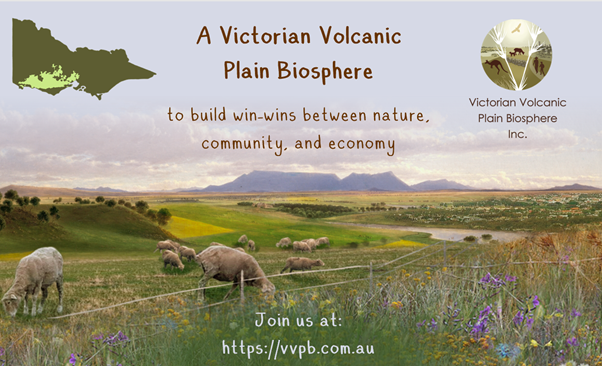
If you have never heard of UNESCO’s Biosphere program (and find yourself surprised to learn there are already four of these Biosphere’s established in Australia – including the Noosa Biosphere which just won UNESCO’s highest award for exceptional Biosphere management!), please check out the VVPB’s latest newsletter and blog post which tells you all you need to know about the program’s history and its potential to contribute to Australian communities.
Biospheres are all about building win-wins between humans and the environment. They recognize that human communities are not separate from nature, and the traditional ‘lock it up’ style reserve conservation does not work for all landscapes, especially those as fragmented as the Victorian Volcanic Plain. Biospheres are built on the belief that human activities can sometimes provide even greater opportunities for habitat conservation, through education, eco-tourism and healthy agricultural industries.
If you want to learn more, or get involved, please come join our group! You can also get in touch with Dr. Elia Pirtle, who is based out of Ararat and is working with the VVPB Inc. to coordinate the project (eliapirtle@gmail.com; 0414143456).
Planting trees is only part of the solution
Margaret Burbidge
Asked in a nationwide poll recently, seventy five percent of Australians said Climate Change (because of global warming) is a big concern to them.

Experts studying climate change tell us that it happens because the globe warms when heat from our sun is trapped by a barrier of excess carbon in the atmosphere. The oceans warm, the ground warms, fish either don’t survive in their natural area, or shift to cooler waters disrupting the natural balance, some crops don’t tolerate a hotter climate and need to shift south too, to grow well. ‘Events’ such as droughts (and fires) and flooding are so much more common.
Of course if we reject the expert climate science studies and predictions, is it too simplistic that we really should reject the science of our iphone, and its amazing communications transmission, our TV too, our car, the daily medications we might take, and so much more, but we don’t.
We’re all responsible for creating excess carbon, but we have sat on our hands with furrowed brows for too long. So don’t ask whether climate change is happening, ask what can we do?
As individuals doing positive things do add up. Drive or fly less. Turn your heater down 1 or 2 degrees (or off if you’re not at home) and put on a woolly jumper. Ask yourself if you really do need that almost empty old spare fridge, with its perished seals, running in the garage. Fit solar panels or switch to green energy. Food shop carefully so there is little or no waste, eat more meat free meals. Think about a large car versus an energy efficient small car. Urge your member of parliament and the government to stop subsidising fossil fuels….
Sharing, making, fixing, upcycling, repurposing are all good places to start. And lastly, add a few shrubs to your garden! It’s not only trees that take in carbon and generate oxygen, all plants do. We must make changes for the sake of our grandchildren.
Update on crown land river frontage camping

Landcare Victoria Inc.
Earlier this year the Victorian Government published proposed regulations to allow greater access to licensed water frontage land for camping. In its submission, Landcare Victoria Inc. in support of member groups and partner organisations made clear that the proposed regulations created risks for these sensitive environments and were contrary to the efforts of landcarers who have worked hard on environmental improvements. An underlying concern is the capacity and commitment of management agencies to enforce any regulations that are made.
The Government has responded positively to our submission, along with many others it received, and has amended its approach. In short, camping will now be permitted only in areas identified as suitable and set aside for the purpose. The relevant regulations came into force on 1 September 2021. Information about the way submissions were considered is here.
The way sites will be identified and assessed as suitable for camping remains unclear. Landcare Victoria Inc. believes that the assessment criteria should be transparent and relevant communities should be consulted before an area is designated. DELWP has published some information about this here. As of 1 September 2021, it appears that no areas have been set aside.
The Government has established a hotline for reports about misconduct in relation to camping. If you witness any illegal fishing call 13FISH.
Andrews Lane Reserve Flora Survey
Over the past twelve months, the Upper Hopkins Land Management Group has been working with Adam Merrick to conduct a flora survey at the Andrews Lane Reserve north of Maroona. The team has documented 49 species at the site, including 24 introduced species. This data will be used to develop a management plan for the site, focusing on managing for biodiversity.
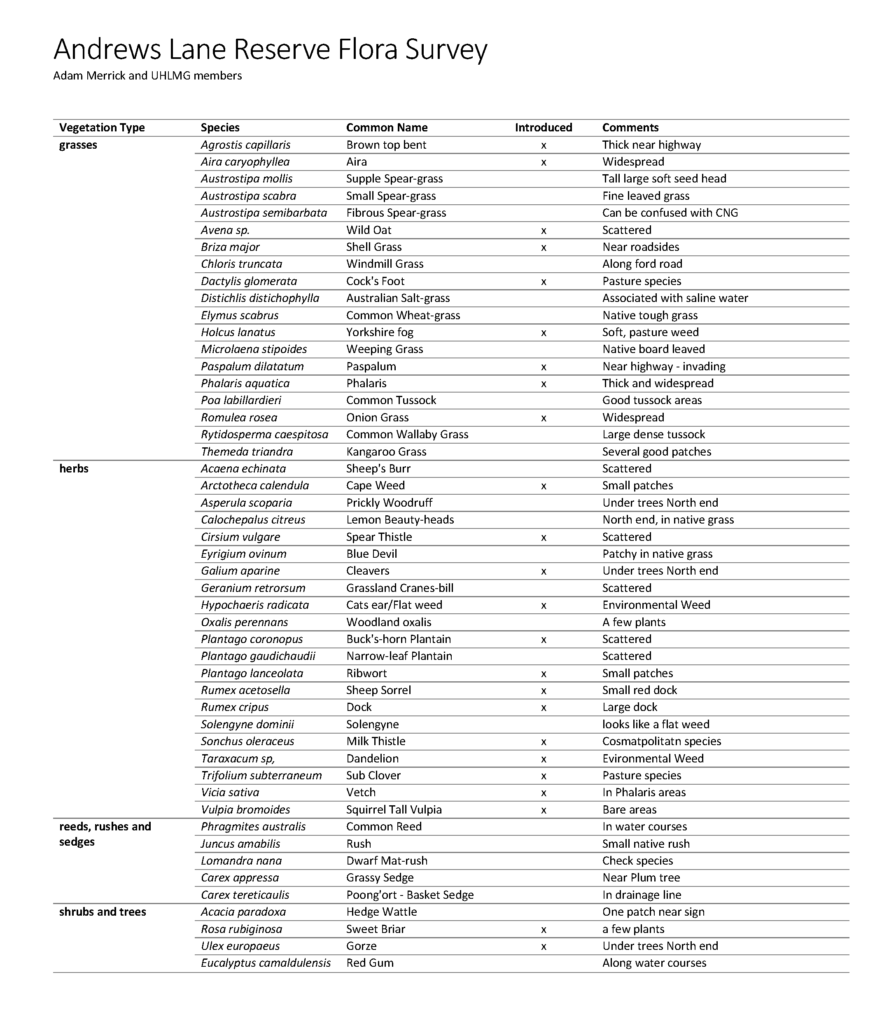

Solengyne, Solengyne dominii 
Common Tussock, Poa labillardieri 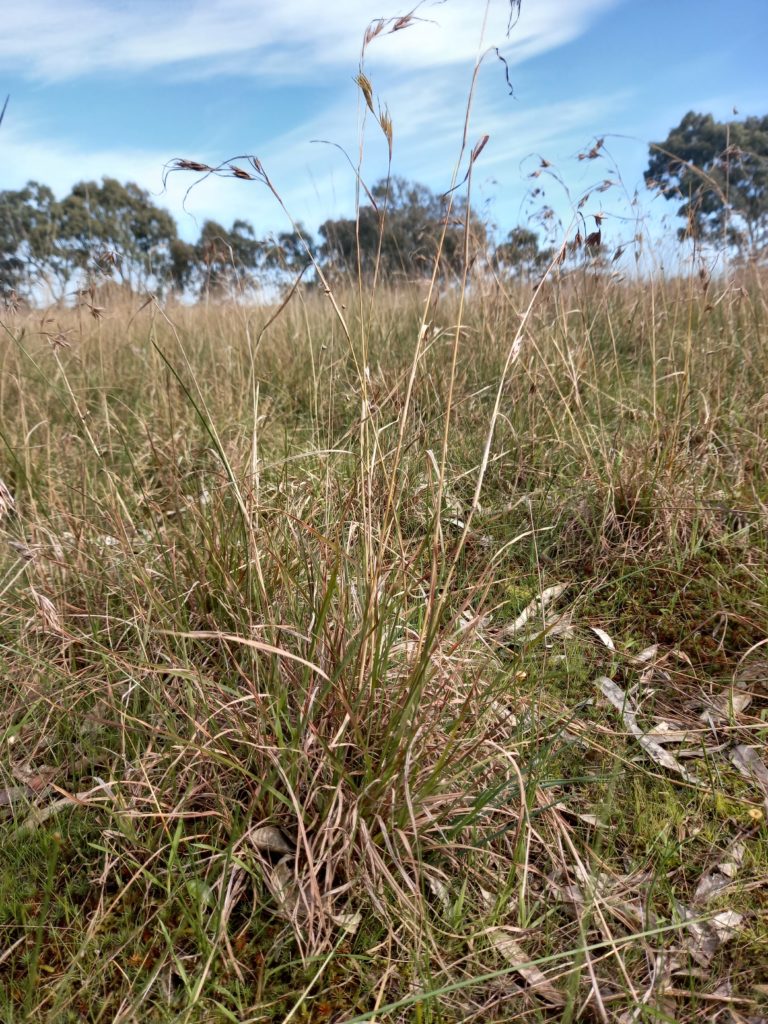
Kangaroo Grass, Themeda triandra
Sallow Wattle – the golden invader

Hannah Auld, Parks Victoria
Home to more than one third of Victoria’s flora, the Grampians (Gariwerd) National Park’s rich biodiversity is under threat from a rapidly spreading native plant species – the Sallow wattle. This plant does not naturally occur in the area and is behaving like a weed, threatening the survival of other important native species in the park.
Sallow Wattle (Acacia longifolia) is native to New South Wales however has been found to be invasive in some parts of Victoria. Unfortunately, northern sections of Grampians (Gariwerd) National Park are highly infested with over seven thousand hectares at risk. Control efforts are being made by Parks Victoria and Volunteers to control this invasive plant which will avoid further dispersion into the greater landscape.

Currently, Sallow Wattle control within the Grampians Landscape is funded by the Victorian Government’s Biodiversity Response Planning program which is helping to ensure that Victoria’s natural environment is healthy, valued and actively cared for. The aim of the control program is to reduce Sallow Wattle density below 30% cover to promote regeneration of native vegetation. Grampians National Park is home to one third of Victoria’s floral diversity with over 75 orchid species.
Sallow Wattle has formed dense woodlands suppressing the growth of these local floral species by out-competing them, threatening the incredible diversity within the park. Sallow Wattle reaches maturity at 18 months and can produce up to 11,500 seeds. The problem intensifies as fires, floods and other major disturbances to soil lead to mass germination.
Identification
It is important that surrounding neighbours of the national park can recognise this invasive plant to assist land managers avoid it spreading on their property. Sallow Wattle is recognised as a dense shrub that can grow into a three to ten-meter-high small tree but can also reach up to a ten-meter-wide tree. Its flowers are yellow, cylindrical and spike in late winter and spring. Its leaves are, unlike most other wattles, bright green, straight and point upwards, they are hardy and waxy to touch. It has two to three prominent, elongated parallel veins. Simple control methods include pulling seedlings out by hand and making sure the root system is also removed. Larger plant trunks need to be cut at ground level, ensuring to cut below the lowest active bud especially on juvenile plants, otherwise there could be a risk of reshooting.
How You Can Help
Parks Victoria organise volunteer activities to help reduce the impact of this invasive plant and to provide opportunities for community members to connect with the local landscape. Two-hour long Volunteer sessions are delivered annually with visiting school groups contributing over 1,000 hours each year. Parks Victoria encourage school groups (Primary through to University) to contact the below staff members if they would like to be involved in the Sallow Wattle Control program. Several information sessions about how to be involved for the public will be delivered online and face to face in the coming months. Information about these sessions will be distributed through newsletters and the Parks Victoria website.
Contact
Enquiries about the information sessions and volunteer activities please contact: hannah.auld@parks.vic.gov.au
Enquiries about the Sallow Wattle control program please contact: marlenne.rodriguez@parks.vic.gov.au
Information about Grampians National Park please visit: www.parks.vic.gov.au
Southern Farming Systems: South West Trail Sites Victoria Report

By Michelle McClure, SFS Events and Communications Coordinator
E:mmclure@sfs.org.auor M: 0488 600692
The team at SFS have finally been able to get out onto paddocks with the tractor to spray after a long slog of hand boom applications. Fungicides have been the main priority, and those trial sites that have been sitting in water have had SOA and urea applied to help them recover. SFS has proceeded with a trial at the Hamilton cereal site with varying nutrition management strategies following waterlogging to show the options – watch this space for developments.
Also in the workings is the extension events for Spring 2021, however the delivery methods pan out, there’s an exciting line up of presenters and discussion for growers to get involved in.
AgriFocus 2021
The Southern Farming Systems Team has been deliberating for a long time on how to deliver AgriFocus in person and online to give members and partners the most value in this crazy COVID regulated world, where at a moment’s notice we can have events or we can’t!
We would like to announce that we have split AgriFocus up into deliverable sections that may or may not have Face2Face(F2F) components dependent on the restrictions of the time.
AgriFocus I, Wednesday 22 September 2021, Live Stream 8.00-10.00am
- Focusing on Crop Integrated Weed Management and Herbicides
- Keynote Speaker: Dr Chris Preston, University of Adelaide having a Q&A Session with James Manson ,SFS about managing the key weeds in the rotation
- Then from the Inverleigh trials there will be 4 short sessions from the field from our contract trial partners looking at different herbicide matrices.
AgriFocus II, Thursday 23 September 2021, Live Stream 8.00-10.00am
- Focusing on Integrated Weed Management and Herbicides in Pastures and Crop
- Keynote Speaker: David Keetch, Nufarm discussing herbicide options in pastures with Lisa Miller, SFS
- Followed by 4 short sessions from the Inverleigh Trials and Projects
AgriFocus III, Wednesday 20 October 2021, If possible, F2F and/or Livestream
- Focusing on Crop Varieties, Disease Management, Soils – Dirt & Diesel Demo, National Landcare Smart Farms Project
More details to come…
Leaky Landscapes: Biolinks Alliance 2021 annual symposium

Sasha Dobson, Project Manager
From the ground up: Climate proofing our landscapes and biodiversity – Practical approach to soil absorption and techniques for fixing desertified landscapes
This year’s symposium will be looking at practical approaches to fixing the damaged landscapes of central Victoria, making them more absorbent (less leaky) and so more biologically productive and better able to withstand the impacts of climate change. It will be a forum for researchers, conservation practitioners, landholders, land managers and interested community members to share information and experiences, form connections and develop collaborative and strategic approaches to ecosystem restoration that specifically aim to restore and climate-proof damaged landscapes by rebuilding soil health and water holding capacity for carbon, hydrology, productivity and biodiversity benefits, thereby improving habitat and resources for threatened species. This forum showcases the 21st century strategies and practical case studies that have been largely missing from policy debates about local environment climate change mitigation.
There is so much more that needs to be done and can be done if we work together effectively to make it happen.
8th October 2021 – Online via Zoom (Keynote speakers include Dr David Tongway, Professor David Watson and Dr Jon Fawcett with more to come)
9th October 2021 – Outdoor field visits, Bendigo region (Covid dependant)
Tickets and the full program will be available soon – keep an eye out by visiting https://biolinksalliance.org.au/leaky-landscapes-symposium, subscribing to the Biolinks Alliance newsletter or following us on Instagram @biolinksalliance
Australasian Bitterns – can you help find this endangered species?
Bradley Clarke-Wood, Wetland Bird Program Coordinator
The notoriously secretive Australasian Bittern is a master of camouflage. Despite being a relatively tall bird, Australasian Bittern manage to keep a low-profile in wetlands with their brown streaked plumage helping them blend in. Bitterns were once widespread across the reedy wetlands of south-eastern Australia, but the degradation and loss of its habitat through development, farming and the damming of watercourses has caused steep population declines. With that said, the Glenelg-Hopkins catchment supports a resident population of Australasian Bittern on the coast and around the Grampians.
This population is the focus of an ambitious monitoring scheme, which forms an essential part of the catchment’s Bittern Recovery Project. This monitoring supports other conservation efforts, funded in part through the Federal Government’s Landcare program and involves many partners that undertake hydrological restoration of drained wetlands, improve privately-owned Bittern habitat through weed and pest control, and create greater structural diversity in dense stand of reeds through Indigenous fire management practices.
In September 2020, a stewardship program was trialed across the catchment with volunteers recruited to deploy (and maintain) an acoustic monitor at their local wetland. The AudioMoth—a low-cost, low-power recording unit that uses an open-source platform for easy access to the recorded data—records up to five hours of audio files per day, and can be programmed so that recording is triggered by the calls of target species. To date, the Stewardship Program has yielded over 1,000 hours of audio data, and the preliminary information emerging is exciting. As well as Australasian Bittern, the dedicated team of early listeners have also identified at least 78 other species, some of which, like the Endangered Growling Grass Frog, are of keen interest to other ecologists who have requested any data that is available.
But with so much audio data and so many potential species to identify, the task ahead is monumental, and BirdLife Australia is calling for more volunteers to help decode the wetland recordings. And no trudging through the swamps is required—this is monitoring in the comfort of your own home, simply through accessing the Arbimon platform through your own computer.
Are you a good listener?
The project still needs good listeners to help us out:
First, we need people to help sort through audio files and produce a list of calling species. And the good news—volunteers can be based anywhere. All you need is a computer, an internet connection and a good ear, and you can access the audio files via the Glenelg-Hopkins Soundscapes project on Arbimon. Volunteers will be trained in how to use Arbimon to validate audio files.
Secondly, we need people to head out to key wetlands at dawn and dusk to do listening surveys to help us identify other sites. Volunteers will be trained in how to conduct listening surveys.
For more information about either opportunity, email Bradley at bradley.clarke-wood@birdlife.org.au


The Audiomoth Stewardship Project is supported by Glenelg Hopkins CMA through funding from the Australian Government’s National Landcare Program.
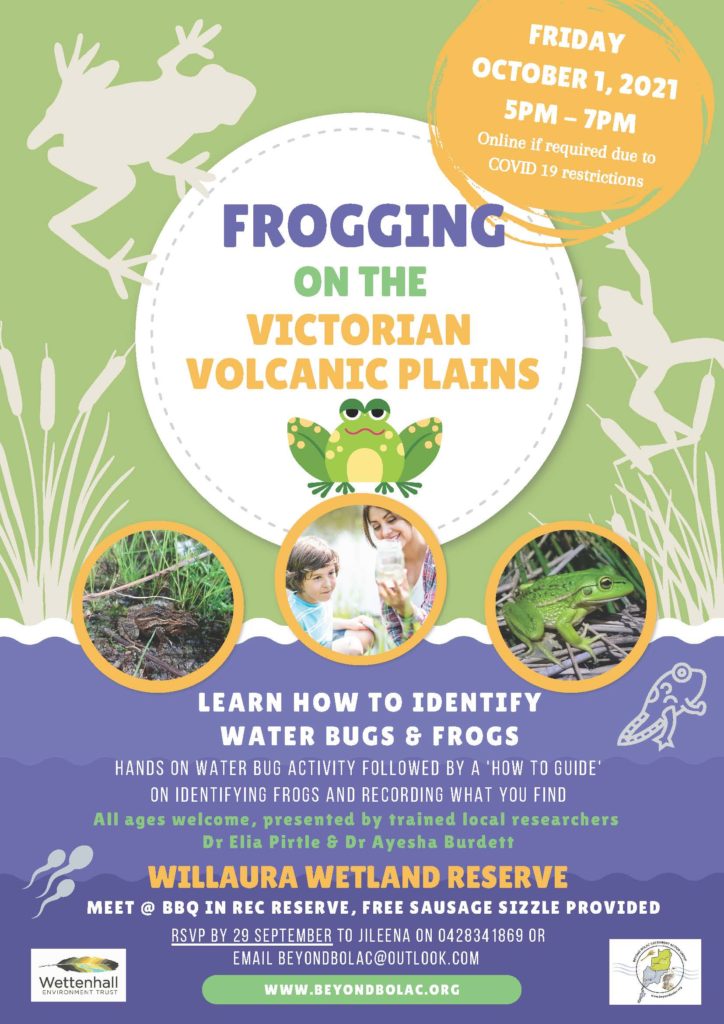
Keeping up with Landcare

Ayesha Burdett, Landcare Facilitator
One of the fortunate outcomes of COVID restrictions is that many conferences are now being held online. If you can carve out enough time in your schedule, it’s a great opportunity to listen to top presenters speaking about their projects from the comfort of your own home. Recently, I have joined a couple of conferences to keep up with Landcaring news
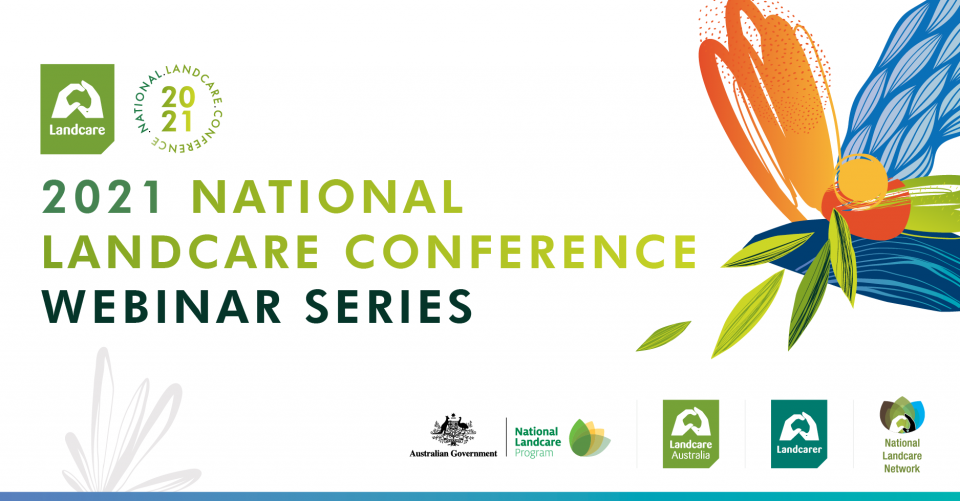
1. The National Landcare Conference
This conference is open to everyone involved in Landcare: volunteers, landholders and farmers, Indigenous land and sea managers, Landcare facilitators and coordinators, educators, research agencies, natural resource management professionals, and other community environmental groups and individuals. It’s an opportunity to connect to others, share insights, and learn about successes and challenges in Landcare projects.
The conference opened with a presentation by John Anderson AO FTSE who reminded us that Landcare was started by and for farmers, but acknowledged that Landcare has evolved a lot since 1986. He emphasised the importance of managing soil health for multiple benefits, included improved agricultural production, carbon storage, and biodiversity outcomes.
Other talks fitted into one of the four topic streams:
Landcare Farming: Landcare and farming, is the connection still valued?
Bushfire Recovery and Resilience: Landcare’s role in recovery of communities, natural assets and farms after bushfire events
Wellbeing and Mental Health Panel: Landcare Is ALL about trees right?
Cultural Land Management Panel: Integrating Indigenous Perspectives for better land management
I was particularly impressed by Dhani Gilbert, a proud young Wiradjuri woman from Ngunnawal country, who had an amazing depth of knowledge and understanding about caring for Country, engaging with community, and the connection between the two.
It is worth making some time to watch a couple of the talks from conference – they will be available online until the end of the September.

2. The Wimmera Biodiversity Seminar
Presentations focus on the theme of “Farming and Biodiversity” and continue to be held online each Thursday in September. The speakers so far have been fantastic and I encourage you to sign up for the remaining presentations.
- Angie Haslem presented the results of a long-term study of revegetation and bird assemblages in the Glenelg Hopkins CMA at the landscape level and at the site level over time. She compared bird diversity in plots with remnant vegetation compared to those that had been revegetated more recently and found that revegetation can take decades to catch up to the habitat diversity and biological diversity of remnant vegetation. It confirms the old adage that the best time to plant a tree was 20 years ago: the second best time is now.
- Elia Pirtle introduced the Victorian Volcanic Plains Biosphere project. It’s an ambitious plan to develop a biosphere right across western Victoria, as a way to create a balance between the grassland ecosystem and current agricultural uses in the region. You can read more about it in our newsletter.
- Jim Radford introduced Farm-scale Natural Capital Accounting (FsNCE) and benefits for farmers. Consumers are now demanding sustainable and ethical products, and large organisations are currently making public commitments to sustainable production. Jim talked about how farmers can measure, manage and report on the stocks and flows of on-farm natural capital, capturing the environmental impacts (positive and negative) of their business.
- Danny Pettingill described a framework to assess and identify landscape function, a tool that can help landowners make decisions to manage land for biodiversity. He has been working on a diversity of projects on the Loddon Plains, and has found that shelterbelts have myriad benefits for the local ecosystem.
If any of these talks sound interesting to you, go to the Wimmera Biodiversity Seminar Facebook page or look on their YouTube channel to see the recorded webinars.
3. Ag Excellence Forum

This one-day event is described as “a networking and knowledge building event that draws producer groups and industry together around a complex topic and the forum to share some of the opportunities that exist to take farm businesses profitably ahead as we move towards a carbon-neutral future.”
The forum was a terrific introduction to managing carbon to mitigate climate change by integrating carbon trading into current agricultural practices.
Fiona Simson (National Farmers Federation) described how the NFF is planning for a strong future by ensuring economic and environmental sustainability for the next generation. Their Climate Change Policy outlines a clear path to 2030 (view it online: https://nff.org.au/key-issue/climate-change/). There are opportunities to lower emissions and to sequester more carbon. Notably, soil science plays an important role in their climate change policy.
Mark Farrell (CSIRO) talked about the challenges of measuring soil organic carbon, and of tracking changes over time, while Mark Holden (ANU) described the technical and strategic challenges that the agricultural industry faces to adapt to climate change.
All of the talks from the AgEx Forum can be viewed online: https://agex.org.au/annual-forum/.


Button Wrinklewort recovery, one seedling at a time

The Glenelg Hopkins CMA is busy planting Button Wrinkleworts across the region. Seed has been collected from seven locations to be sown and raised by David Franklin in his Grassland Flora nursery at Chatsworth. Over 2,000 of these seedlings are now being planted at three different sites in the Upper Hopkins and one site near Dunkeld. In the future, these plants will be used as a seed source for more revegetation projects.
One of these sites is the property of Peter and Christine Forster at Bullock Hills, just south of Ararat. I was fortunate to join the working bee to help plant out 500 seedlings in their paddock, which has recently been covenanted to protect native grassland. In the past, Ararat Landcare Group and Ararat College helped plant out the adjoining paddock with native trees. It’s going to be great to watch the ongoing recovery of groundcover species on this property.
The Button Wrinklewort project is led by Aggie Stevenson and Ben Zeeman. The long-term goal of the project is to give this threatened daisy the best chance of persisting in Western Victoria, which is being done through implementing the Rutidosis Planting and Monitoring Protocol 2020, a guide prepared by ecologists form the Arthur Rylah Institute (ARI).
To learn more about the Button Wrinklewort, be sure to look for the Lonely Button Wrinklewort on Facebook (https://www.facebook.com/buttonwrinklewort) or contact Aggie at a.stevenson@ghcma.vic.gov.au or 0435 537 443.
This project is supported by Glenelg Hopkins CMA, through funding from the Australian Government’s National Landcare Program.


Meanderings and reflections
All of the little creeks and tributaries in the Upper Hopkins are flowing! It’s been a long, wet winter and it was great to see so much water in our catchment. Lake Buninjon and Lake Bolac are brimming full, and there is still more water coming from upstream.
All of the recent rain means that water was quite turbid across the Upper Hopkins as sediment was carried off the paddock and downstream. As we Landcarers know, planting trees and fencing waterways can help reduce the amount of erosion from streambanks. It’s always fortifying to see areas with remnant vegetation holding soil together and creating habitat for riparian and in-stream fauna. I have also noticed that a lot of vegetation that has been planted in the last few years is really starting to take off and flourish in biodiversity corridors and fenced-off waterways. Thanks to everyone who has been working on their own land for so many years – you’re really making a difference to the whole region!

Yalla-Y-Poora Road ford 
Rossbridge Wildlife Reserve 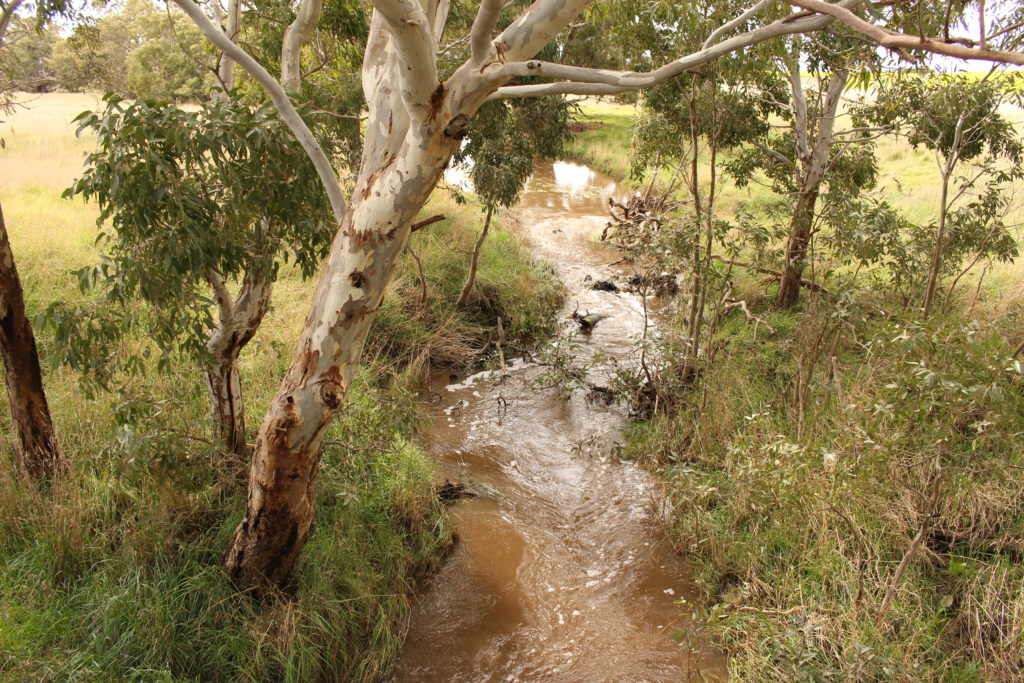
Challicum Creek
Water monitoring results
You can view the EC data in the table below, or click on the link to download a file. Numbers in bold exceed 6,000 EC μS/cm.
EC levels for livestock water supplies. Value given in brackets for each type of livestock is the EC level at which production decline begins: Beef cattle (6,200 EC μS/cm), lactating ewes and weaners (6,000 EC μS/cm), dry sheep (9,300 EC μS/cm)), horses (6,200 EC μS/cm), Pigs (3,100 EC μS/cm), poultry 3,100 EC μS/cm).












